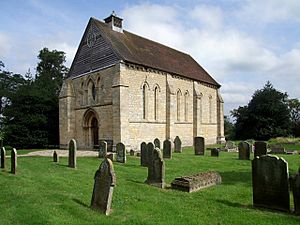St Leonard's Without facts for kids
Quick facts for kids St Leonard's Without |
|
|---|---|

The Church of St Leonard, Kirkstead
|
|
| 53°08′10″N 0°13′21″W / 53.13611°N 0.22250°W | |
| Denomination | Church of England |
| Website | https://woodhallspa.group/kirkstead |
| History | |
| Dedication | Leonard of Noblac |
| Administration | |
| Diocese | Diocese of Lincoln |
The church of St Leonard's Without is a small chapel. It was built between 1230 and 1240. You can find it in the area of Kirkstead, Lincolnshire, near Woodhall Spa.
This chapel is very old and has an interesting history. It is a special building because of its age and unique design.
What is St Leonard's Without?
St Leonard's Without is a historic chapel. It is located close to the ruins of Kirkstead Abbey. This abbey was founded way back in 1139. The chapel served as the capella ante portas for the abbey. This Latin phrase means "chapel outside the gates." Its name, "Without," also means "outside." This shows it was built just outside the main walls of the monastery.
A Special Building Style
St Leonard's Without is a Grade I listed building. This means it is a very important historic building. It is a great example of the Early English style. This style was popular in England during the 13th century. It features tall, narrow windows and pointed arches.
Even though the chapel is small, it is built to a very high standard. It measures about 12.8 meters long and 5.8 meters wide. Some people think it was built as a chantry chapel. A chantry chapel was a place where prayers were said for someone who had died. This one might have been built for Robert de Tattershall, who passed away in 1212.
Saving the Chapel
For many centuries, St Leonard's Without was used as a church. However, it closed in 1877. A group of people called Presbyterians were asked to leave. After that, the chapel started to fall apart.
In 1883, a group called the Society for the Protection of Ancient Buildings stepped in. They worked hard to save the chapel from being completely destroyed. Finally, between 1913 and 1914, the chapel was restored. An architect named William Weir led this important work. Thanks to these efforts, we can still see and appreciate this historic chapel today.

